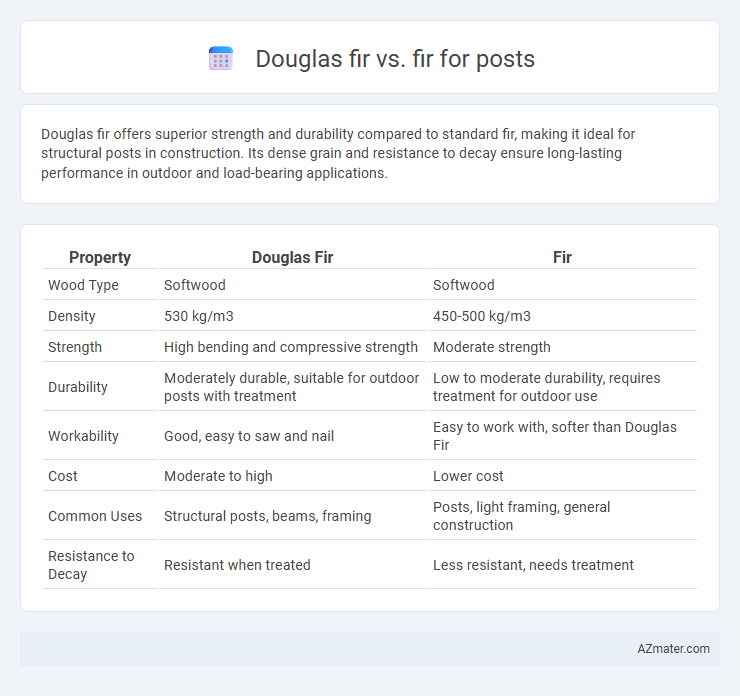Douglas fir offers superior strength and durability compared to standard fir, making it ideal for structural posts in construction. Its dense grain and resistance to decay ensure long-lasting performance in outdoor and load-bearing applications.
Table of Comparison
| Property | Douglas Fir | Fir |
|---|---|---|
| Wood Type | Softwood | Softwood |
| Density | 530 kg/m3 | 450-500 kg/m3 |
| Strength | High bending and compressive strength | Moderate strength |
| Durability | Moderately durable, suitable for outdoor posts with treatment | Low to moderate durability, requires treatment for outdoor use |
| Workability | Good, easy to saw and nail | Easy to work with, softer than Douglas Fir |
| Cost | Moderate to high | Lower cost |
| Common Uses | Structural posts, beams, framing | Posts, light framing, general construction |
| Resistance to Decay | Resistant when treated | Less resistant, needs treatment |
Introduction to Douglas Fir and Fir for Posts
Douglas fir is a popular choice for posts due to its exceptional strength, durability, and resistance to decay, making it ideal for outdoor construction projects. Fir, generally referring to species like balsam or white fir, tends to be softer and less dense, offering less structural support compared to Douglas fir. When selecting wood for posts, Douglas fir provides superior load-bearing capacity and longevity, especially in environments exposed to weather.
Botanical Differences: Douglas Fir vs True Fir
Douglas fir (Pseudotsuga menziesii) is not a true fir and belongs to a separate genus, characterized by longer, hairy cones with distinctive three-pointed bracts extending beyond the scales. True firs (genus Abies) have shorter cones that disintegrate on the tree, with upright, cylindrical shapes and smooth-edged needles attached singly to branches. Botanically, Douglas fir needles are soft, flat, and arranged spirally, contrasting with the flattened, often two-ranked needles of true firs, highlighting key identification differences essential for post selection and durability considerations.
Strength and Durability Comparison
Douglas fir offers superior strength and durability compared to common fir species, making it an ideal choice for posts requiring heavy load-bearing capacity. Its dense grain structure provides enhanced resistance to bending and compression, ensuring long-lasting performance in structural applications. Fir posts, while generally lighter and less costly, lack the robustness and decay resistance found in Douglas fir, which limits their suitability for demanding outdoor use.
Natural Resistance to Rot and Insects
Douglas fir exhibits superior natural resistance to rot and insect damage compared to common fir species, making it a preferred choice for outdoor posts and structural applications. Its dense grain and high resin content enhance durability in moist environments, reducing the need for chemical treatments. Fir wood, while economical, generally lacks these protective properties and requires additional preservatives to withstand decay and insect infestation.
Workability and Ease of Installation
Douglas fir offers superior workability and ease of installation compared to other fir species due to its straight grain and consistent density, which allows for smoother cuts and better nail holding capacity. Its moderate hardness reduces the risk of splitting when driving fasteners, making it ideal for posts requiring structural strength. Fir species like balsam or white fir tend to be softer and more prone to warping, complicating installation and reducing long-term durability.
Appearance and Grain Characteristics
Douglas fir features a distinctive reddish-brown color with a coarse, straight grain that offers a robust and attractive appearance for posts. Fir, typically referring to species like balsam or white fir, presents a lighter, pale yellowish hue with a finer, more uniform grain texture. The pronounced grain patterns of Douglas fir provide better visual appeal and potential for finishing, making it a preferred choice for decorative posts.
Cost Analysis: Douglas Fir vs Fir for Posts
Douglas fir posts generally cost more than standard fir posts due to their superior strength, durability, and resistance to decay, making them a preferred choice for structural applications. While fir posts are more economical upfront, they may require more frequent maintenance or replacements, increasing long-term expenses. Choosing Douglas fir can result in lower lifecycle costs despite higher initial investment, especially in projects demanding longevity and load-bearing capacity.
Regional Availability and Sourcing
Douglas fir is primarily sourced from the Pacific Northwest region of the United States and Canada, making it readily available and cost-effective in these areas for post construction. Fir, often referring to species like balsam or white fir, is more commonly found in the northern and eastern United States, impacting regional availability and pricing. Sourcing posts locally reduces transportation costs and environmental impact, so choosing Douglas fir or fir depends largely on the geographic location and its native forestry resources.
Environmental Impact and Sustainability
Douglas fir offers a lower environmental impact compared to traditional fir species due to its faster growth rate and higher carbon sequestration capabilities, which contribute to sustainable forestry practices. Its durability extends the lifespan of posts, reducing the need for frequent replacements and minimizing resource consumption. Selecting Douglas fir for posts supports responsible forest management and promotes ecological balance by favoring renewable timber sources.
Best Applications: Which Fir is Ideal for Structural Posts?
Douglas fir outperforms other fir species for structural posts due to its superior strength, density, and durability, making it ideal for load-bearing applications in construction. True firs such as balsam or red fir are generally softer and less dense, limiting their use primarily to non-structural or decorative posts. For applications requiring long-lasting, high-performance posts capable of withstanding heavy loads and environmental stress, Douglas fir remains the preferred choice.

Infographic: Douglas fir vs Fir for Post
 azmater.com
azmater.com